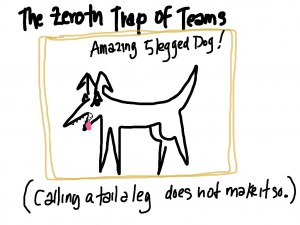A team is a social unit, a group of people who work collaboratively to accomplish some goal. Every team is a group of people, but not every group of people is a team. I hear the term applied loosely–describing anything from a collection of individual contributors to everyone in a department. However, teams share certain characteristics and pre-conditions. These create the environment where collaboration, shared accountability, and creativity are likely to thrive.
“If you call a tail a leg, how many legs has a dog? Five? No, calling a tail a leg don’t make it a leg.” Abraham Lincoln
Characteristics of Teams
Researchers who study teams identify these enabling conditions that support a group becoming a team.
Teams….
- Share a compelling work goal, one that is well-understood by all members of the team. They result they are producing is eagerly awaited by some person or persons–else there is no reason for the team. Without goal outside the team, a group may form a social unit, but they are not a team.
- Are mutually accountable for that goal. Team members do focus on completing their work; but they know that completing individual task isn’t success. Success comes from achieving the over all goal.
- Are doing interdependent work that requires the skills of all to create a finished product. Their skills are complementary and it is the combination of their skills that enables them to reach their goal. It’s not like a ski team where everyone has the same skills, and the team result is the sum of individual scores. On a team, the results aren’t additive, they’re integrative, generative, and collective.
- Have a shared approach (though not a rigid process). Team members make agreements on how they will work together. They choose methods that fit the work and the goal. They need enough constraints on process so that they can work creatively–avoiding both anarchy and stifling routine.
- Teams almost always have fewer than ten members. Some say five is the sweet spot. When there are fewer than five members, there’s not much sense of “teaminess.” When there are more than ten, the work is so big that it breaks on along natural lines…and so do the people, falling into sub-groups that act more like a team than the bigger unit.
- Have shared history/identity. This implies that a group is not a team on it’s first day together. It also implies that shaking up groups every few weeks or months ensures that you’ll never really achieve the surpassing results that cohesive teams are capable of.
Fit for Function
Different work calls for different types of organization
Some work is much better done by a team, some work needs a group, and some needs many same-skilled individuals. It depends on the how interdependent and tightly coupled the work is. Growing teams takes energy and commitment–both from team member and managers. If the work doesn’t require cross-functional collaboration on a day-to-day basis, the work doesn’t need a team. (But beware of inappropriate serialization.)
You may be interested in my Creating an Environment for Teams Assessment.
Updated October 2020.




As to ‘Share a compelling work goal’, a big part of the problem that most agile development methodologies make no distinction between goals and requirements.
There is really good work by James Shore, Gojko Adzic, Dan North and BDD community, and others that offer structure around goal-centric planning. But this seems to be exception rather than the rule.
I would also posit that the recent rallying cries for ‘technical excellence’ will fall upon deaf ears because teams without such ‘compelling goals’ will not be as motivated to care about the quality of work.